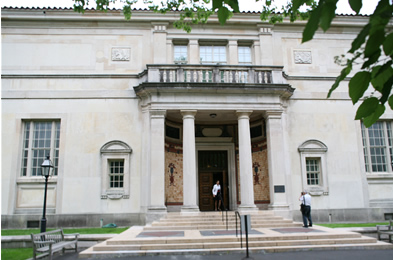Back to Philadelphia: Tod Williams and Billie Tsien Will Design the new Barnes Foundation
 One of the nice things about Tod Williams and Billie Tsien Architects winning the commission for the Barnes Foundation (as I reported today) is that it means that they will get a chance to do a second Philadelphia building. They are responsible for the best new building in Philadelphia: Skirkanich Hall labs at Penn, which I reviewed in 2006, and when the design was first presented in 2004. But in this day of jet-setting stararchitects, it's rare for a designer to come back for a return engagement.
One of the nice things about Tod Williams and Billie Tsien Architects winning the commission for the Barnes Foundation (as I reported today) is that it means that they will get a chance to do a second Philadelphia building. They are responsible for the best new building in Philadelphia: Skirkanich Hall labs at Penn, which I reviewed in 2006, and when the design was first presented in 2004. But in this day of jet-setting stararchitects, it's rare for a designer to come back for a return engagement.The new Barnes won't necessarily start up a dialogue with Skirkanich. But the architects did tell me during our interview yesterday that they intended to "top" what they did at Skirkanich, so it's obviously a point of departure. These days, two major buildings by the same designers, in the same city is practically a body of work.
 I've always felt you can't understand an architect just by looking at one building. You get more meaning and enjoyment when you are able to see the same ideas applied to different problems, and can pick out the variations on a theme. It might take three or four years, but Philadelphians will eventually have a little compare-and-contrast exercise to ruminate over.
I've always felt you can't understand an architect just by looking at one building. You get more meaning and enjoyment when you are able to see the same ideas applied to different problems, and can pick out the variations on a theme. It might take three or four years, but Philadelphians will eventually have a little compare-and-contrast exercise to ruminate over.Williams and Tsien don't have a huge list of completed works, but they are represented on both coasts by excellent projects, the American Folk Art Museum in New York and the Neurosciences Institute in La Jolla, California. All their projects are distinguished by an effort to bring the landscape into the building and blur the boundaries between indoors and out. That's exactly right for the Barnes collection , which is so thoroughly integrated with the landscape surrounding Paul Cret's limestone villa in Merion. The experience obviously won't be the same on the Parkway, but it could be wonderful in its own right.



